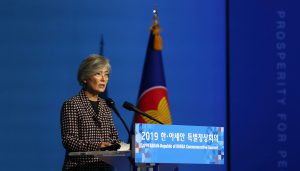Despite intense focus on South Korea’s renewed push for inter-Korea engagement, the Moon Jae-in government continues to expand its outreach to Southeast Asia and India through its New Southern Policy (NSP). President Moon demonstrated his commitment to Southeast Asia, visiting all 10 ASEAN countries in his first two years in office. In November 2019, the South Korean president hosted ASEAN state leaders in Busan for the ASEAN-Republic of Korea (ROK) commemorative summit celebrating 30 years of ASEAN-South Korea relations.
What explains South Korea’s southern pivot, and what challenges and opportunities lie ahead for the NSP as the Moon government prepares to unveil NSP 2.0 later this year?
Moon unveiled the NSP in November 2017 in the midst of China’s economic boycott against South Korean products and entertainment and tourism industry. Although Moon’s 2017 election manifesto had mentioned elevating relations with ASEAN on par with South Korea’s four major Northeast Asian partners (the United States, China, Russia, and Japan), China’s punitive response to South Korea’s decision to permit the U.S. deployment of the THAAD missile defense system underscored Seoul’s vulnerability to Chinese economic dependence. In light of economic and geostrategic realities, three inter-related reasons explain the Moon government’s shift to ASEAN through the NSP.
First, strengthening ties with ASEAN enables South Korea to diversify its foreign policy strategy. By relying more on ASEAN’s export market and expanding trade and investment with countries such as Vietnam, Indonesia, Malaysia, the Philippines, and Thailand, Seoul can reduce the risks of Chinese economic coercion and U.S.-China trade friction. Additionally, with U.S.-China geostrategic competition heating up, South Korea and ASEAN can draw on their middle power status to bolster regional security cooperation and protect their interests from any potential superpower fallout.
Second, untapped economic opportunities exist in Southeast Asia that merit elevating ASEAN-South Korea relations, regardless of Seoul’s need for diversification. Since signing a series of economic agreements in the mid-2000s, ASEAN has become South Korea’s second largest trading partner and second largest overseas construction market after the Middle East. The Moon government has presented an ambitious goal of reaching $200 billion in trade with ASEAN by the end of this year, or nearly $50 billion more than in 2017.
South Korean firms have expanded their regional investment in the processing and manufacturing, logistics, and shipbuilding sectors where South Korea holds comparative advantages. Heading into the future, the NSP will accelerate the fourth industrial revolution by boosting cooperation in the financial, information and communication, digital, and biotechnology sectors. South Korea has also pledged to work with ASEAN to develop ASEAN’s smart cities network to promote sustainable urban development.
Third, the NSP allows South Korea to maintain some semblance of foreign policy autonomy. South Korea has engaged, but not embraced, the Trump administration’s free and open Indo-Pacific (FOIP) strategy. To this end, the NSP provides ample room for cooperation on economic and local governance initiatives central to FOIP including energy, infrastructure and development, digital economy, and women’s empowerment. However, by not infusing the NSP with FOIP language, the NSP reflects a framework somewhat distinct from the Indo-Pacific strategies adopted by other U.S. allies such as Japan and Australia.
Given sufficient mutual interests in ASEAN-South Korea relations, sustained cooperation will likely persist beyond the Moon government. However, additional challenges lay ahead as Seoul aims to streamline the NSP into more specific joint actions for delivery with Southeast Asian partners and India under NSP 2.0.
South Korea has signaled its political will and ambitions for the policy by creating a presidential committee on the NSP and through high profile diplomatic meetings and summits. To date, Seoul has emphasized the prosperity and people dimensions of the NSP where progress is more tangible, and domestic political points readily gained. Absent in much of this discussion, however, are important issues of convergence on the strategic front. Security cooperation lags behind economic and socio-cultural cooperation. The strategic gap in the NSP is not entirely Seoul’s doing. ASEAN has also tended to eschew traditional security issues as it remains sensitive to being drawn into the security affairs of external powers.
Unfortunately, Chinese assertiveness in the region has not abated, making it politically difficult for South Korea and ASEAN to ignore security cooperation in the long term. For now, the Moon government has endorsed the ASEAN Outlook on the Indo-Pacific (AOIP), which can serve as a benchmark for addressing cooperative security issues. Maritime cooperation is one significant area of concern for ASEAN in the AOIP that South Korea might help address. ASEAN members may therefore look increasingly toward South Korea for weapons procurement, including big ticket items such as ships and submarines.
More immediately, South Korea can do more to promote the peace pillar of the NSP and regional stability by amplifying ASEAN norms and initiatives such as ASEAN’s code of conduct in the South China Sea. Nontraditional security issues such as climate change and pandemics have become a strong point in South Korea’s domestic policy arena and might be leveraged to strengthen the peace pillar in NSP 2.0. Although the NSP has been criticized for lacking clear priorities or a large-scale legacy project, shoring up the peace pillar, in addition to prioritizing a few key projects, may help give the NSP a stronger foundation and greater purpose in advancing regional stability and cooperation.
Andrew Yeo is Professor of Politics at The Catholic University of America. He is the author of “Asia’s Regional Architecture: Alliances and Institutions in the Pacific Century” and a recent CSIS report on South Korea and the Free and Open Indo-Pacific.

































